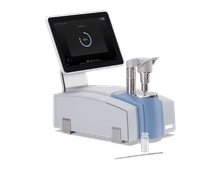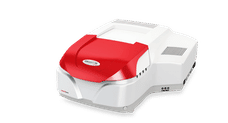Neutrinos are lighter than 0.8 electron volts
KATRIN experiment with new world record for precision measurements
Advertisement
The international KArlsruhe TRItium Neutrino Experiment (KATRIN), located at Karlsruhe Institute of Technology (KIT), has broken an important "barrier" in neutrino physics which is relevant for both particle physics and cosmology. Based on data published in the prestigious journal Nature Physics, a new upper limit of 0.8 electronvolt (*) for the mass of the neutrino has been obtained. This first push into the sub-eV mass scale of neutrinos by a model-independent laboratory method allows KATRIN to constrain the mass of these "lightweights of the universe" with unprecedented precision.

View into the interior of the main spectrometer of the KATRIN experiment for the determination of the neutrino mass
Markus Breig, KIT
Neutrinos are arguably the most fascinating elementary particle in our universe. In cosmology they play an important role in the formation of large-scale structures, while in particle physics their tiny but non-zero mass sets them apart, pointing to new physics phenomena beyond our current theories. Without a measurement of the mass scale of neutrinos our understanding of the universe will remain incomplete.
This is the challenge the international KATRIN experiment at Karlsruhe Institute of Technology (KIT) with partners from six countries has taken up as the world´s most sensitive scale for neutrinos. It makes use of the beta decay of tritium, an unstable hydrogen isotope, to determine the mass of the neutrino via the energy distribution of electrons released in the decay process. This necessitates a major technological effort: the 70 meter long experiment houses the world´s most intense tritium source as well as a giant spectrometer to measure the energy of decay electrons with unprecedented precision.
The high quality of the data after starting scientific measurements in 2019 has continuously been improved over the last two years. "KATRIN is an experiment with the highest technological requirements and is now running like perfect clockwork" enthuses Guido Drexlin (KIT), the project leader and one of the two co-spokespersons of the experiment. Christian Weinheimer (University of Münster), the other co-spokesperson, adds that "the increase of the signal rate and the reduction of background rate were decisive for the new result".
Meticulous data analysis: First foray into the range below one electronvolt
The in-depth analysis of this data was demanding everything from the international analysis team led by its two coordinators, Susanne Mertens (Max Planck Institute for Physics and TU Munich). Magnus Schlösser (KIT). Each and every effect, no matter how small, had to be investigated in detail. "Only by this laborious and intricate method we were able to exclude a systematic bias of our result due to distorting processes. We are particularly proud of our analysis team which successfully took up this huge challenge with great commitment", the two analysis coordinators are pleased to report.
The experimental data from the first year of measurements and the modeling based on a vanishingly small neutrino mass match perfectly: from this, a new upper limit on the neutrino mass of 0.8 electronvolt (eV) can be determined (Nature Physics, July 2021). This is the first time that a direct neutrino mass experiment has entered the cosmologically and particle-physically important sub-eV mass range, where the fundamental mass scale of neutrinos is suspected to be. "The particle physics community is excited that the 1-eV-barrier has been broken by KATRIN", comments neutrino expert John Wilkerson (University of North Carolina, Chair of the Executive Board).
Susanne Mertens explains the path to the new record: "Our team at the MPP in Munich has developed a new analysis method for KATRIN that is specially optimized for the requirements of this high-precision measurement. This strategy has been successfully used for past and current results. My group is highly motivated: We will continue to meet the future challenges of KATRIN analysis with new creative ideas and meticulous accuracy."
Further measurements should improve sensitivity
The co-spokespersons and analysis coordinators of KATRIN are very optimistic about the future: "Further measurements of the neutrino mass will continue until the end of 2024. To realise the full potential of this unique experiment, we will not only steadily increase the statistics of signal events, we are continuously developing and installing improvements to further lower the background rate."
The development of a new detector system (TRISTAN) plays a specific role in this, allowing KATRIN from 2025 on to embark on a search for "sterile" neutrinos with masses in the kiloelectronvolt-range, a candidate for the mysterious dark matter in the cosmos that has already manifested itself in many astrophysical and cosmological observations, but whose particle-physical nature is still unknown.
(*) 1 electronvolt is equivalent to the inconceivably small mass of approximately 1,8 x 10-36 kilograms
















































































